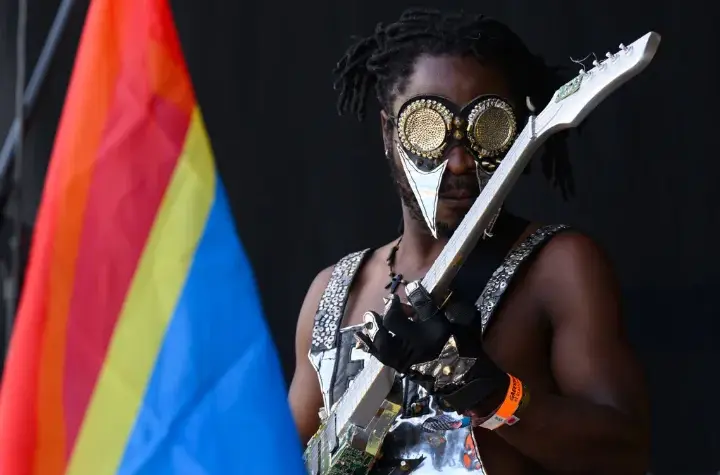DR.Congo
Heading 2
Heading 2
Heading 2

Fulu Miziki from DRC lit up Glastonbury 2024 with recycled instruments and raw energy on the Greenpeace stage.
Explore Culture of the DR Congo: Language, Arts, Music, and Identity
Discover the rich and diverse culture of DR Congo, exploring its languages, religion, traditional art, literature, fashion, music, and modern cultural revival.
7/30/25, 2:46 PM
Introduction: Congo’s Cultural Soul
The Democratic Republic of the Congo (DRC) is often celebrated for its immense natural wealth, but few are aware that it is also one of Africa’s richest cultural nations. With over 250 ethnic groups, multiple languages, vibrant music and dance, legendary sculptors, and a fashion culture that inspires trends across Africa, Congo is not just a place, it’s a living, breathing cultural force.
As the Congo opens to tourism and global partnerships, understanding its culture is crucial to grasping its resilience, creativity, and identity.
Ethnic Groups and Language: The Cultural Mosaic
DRC is home to more than 250 ethnic groups, each with unique customs, stories, and histories. While French is the official language used in government and education, the real soul of the country beats through its four national languages:
Lingala (used in music and the military)
Swahili (spoken in the east)
Kikongo (used in the West)
Tshiluba (in the south-central region)
Despite colonial attempts to divide communities through tribalism, today’s Congolese culture continues to promote unity through linguistic diversity and regional pride.
Religion and Spiritual Life
The majority of Congolese are Christians, mainly Catholics (46-48%) and Protestants (26-28%), but the spiritual traditions go deeper. Many still honor traditional beliefs, worshipping one supreme god through spirits and ancestors.
Unique Congolese movements like Kimbanguism and figures such as Kimpa Vita (the Black Joan of Arc) played a massive role in mixing Christianity with African spiritual heritage, promoting unity, resistance, and identity.
Congolese Literature: Words of Resistance and Reflection
From Patrice Lumumba’s political letters to modern novels and poetry, Congolese literature has become a tool of resistance and expression. Notable writers include:
Pie Tshibanda
Elikia M’bokolo
Maguy Rashidi-Kabamba
Kama Kamanda
Thomas Kanza
Many writers, especially in the diaspora, use storytelling to raise awareness about war, injustice, and the exploitation of Congo’s land and people.
Theater: Storytelling with Soul
Theater thrives in Congo, especially in Kinshasa, where creative groups emerged in the 1970s and 80s. Productions blend drumming, dance, dream sequences, and African griot narration, showcasing local legends and societal issues.
Famous groups like Groupe Salongo and Minzoto Wela Wela toured nationally and internationally, and continue to inspire a new generation of performers today.
Sculpture, Masks, and Traditional Art
Congo’s artistic traditions are unmatched in Africa. Its masks and sculptures influenced none other than Pablo Picasso, who was deeply inspired by the Pende Mbuya (sickness) mask in his Cubist masterpiece Les Demoiselles d’Avignon.
With over 50 sculpture styles, each tribe produces its iconic forms, from the elongated Mangbetu figures to Songye power statues. Art is functional, spiritual, and decorative, crafted using wood, ivory, metal, feathers, cowries, and more.
Music: Congo’s Global Soundtrack
Music is Congo’s heartbeat. From the 1940s troubadours to the golden age of Congo Jazz and the Ndombolo dance wave, Congolese Rhumba music has swept across Africa.
Key names include:
Franco Luambo Makiadi
Tabu Ley Rochereau
Papa Wemba
Koffi Olomide
Fally Ipupa
Mbilia Bel
Tshala Muana
Genres like Soukous, Kwassa Kwassa, and Ndombolo transformed dance floors from Kinshasa to Paris. Lingala, the dominant language in lyrics, brings rhythm and romance to every beat.
Fashion: Style with a Statement
Congolese fashion centers around the colorful pagne (wax print) fabric, often printed with symbols, sayings, or political messages. Pagne is worn for weddings, protests, church, and everyday life.
Urban youth blend this tradition with global fashion trends, creating a vibrant street style scene, especially in Kinshasa and Lubumbashi.
Congolese fashion isn’t just about appearance; it’s a form of expression, pride, and social status.
Culture as Identity and Power
In today’s globalized world, where local cultures are often overshadowed, Congolese people continue to defend and celebrate their cultural identity. Whether through music, language, or ritual, culture remains a tool for healing, resistance, and transformation in DR Congo.
Final Reflection
The culture of the Democratic Republic of Congo is as deep as its rainforests and as powerful as the Congo River. It is complex, diverse, and alive. To understand Congo is to engage with its music, art, fashion, languages, and stories.
So whether you're visiting Virunga National Park or dancing to a Ndombolo beat, know that you're experiencing a culture shaped by centuries of resilience, creativity, and community.
You May Also Like







